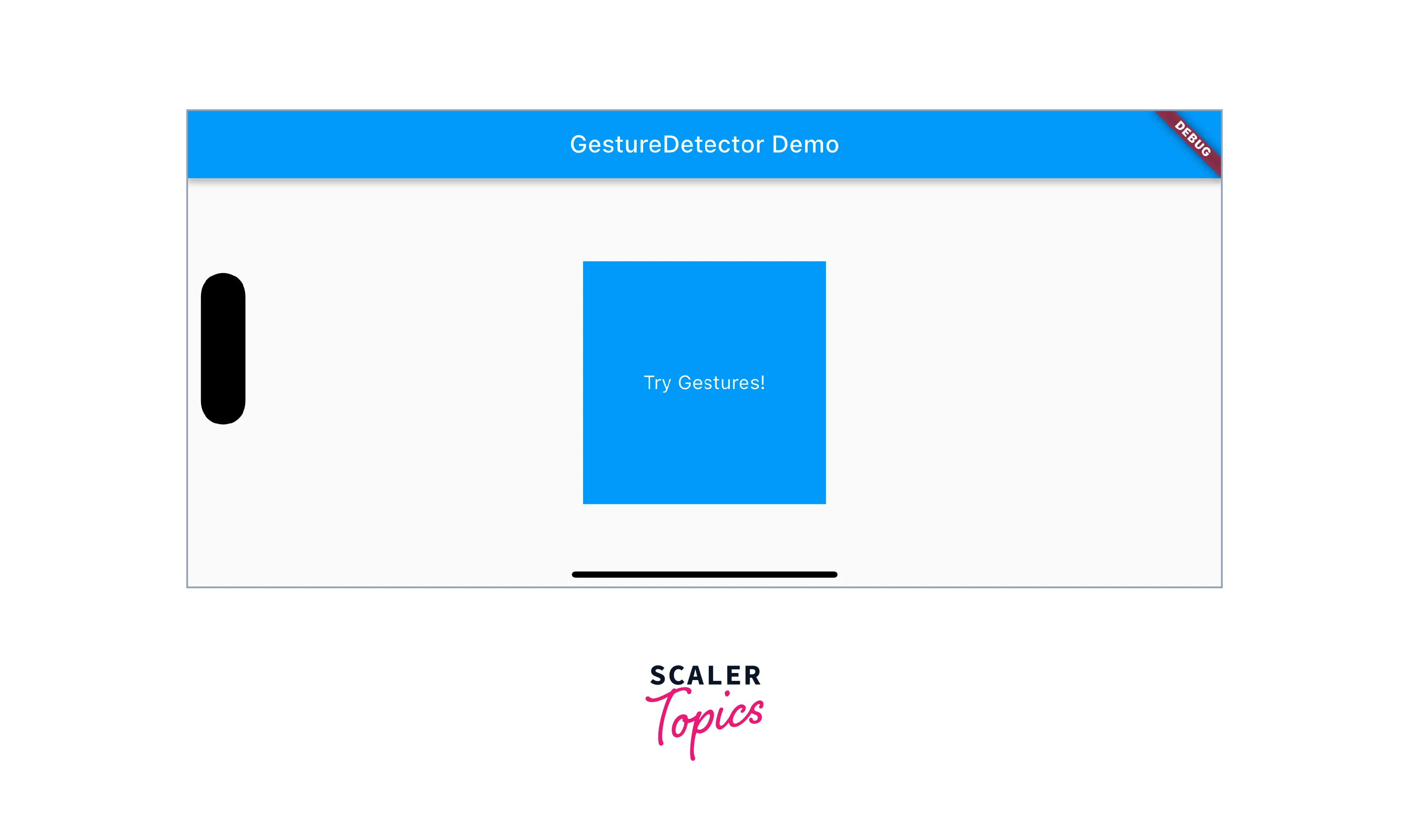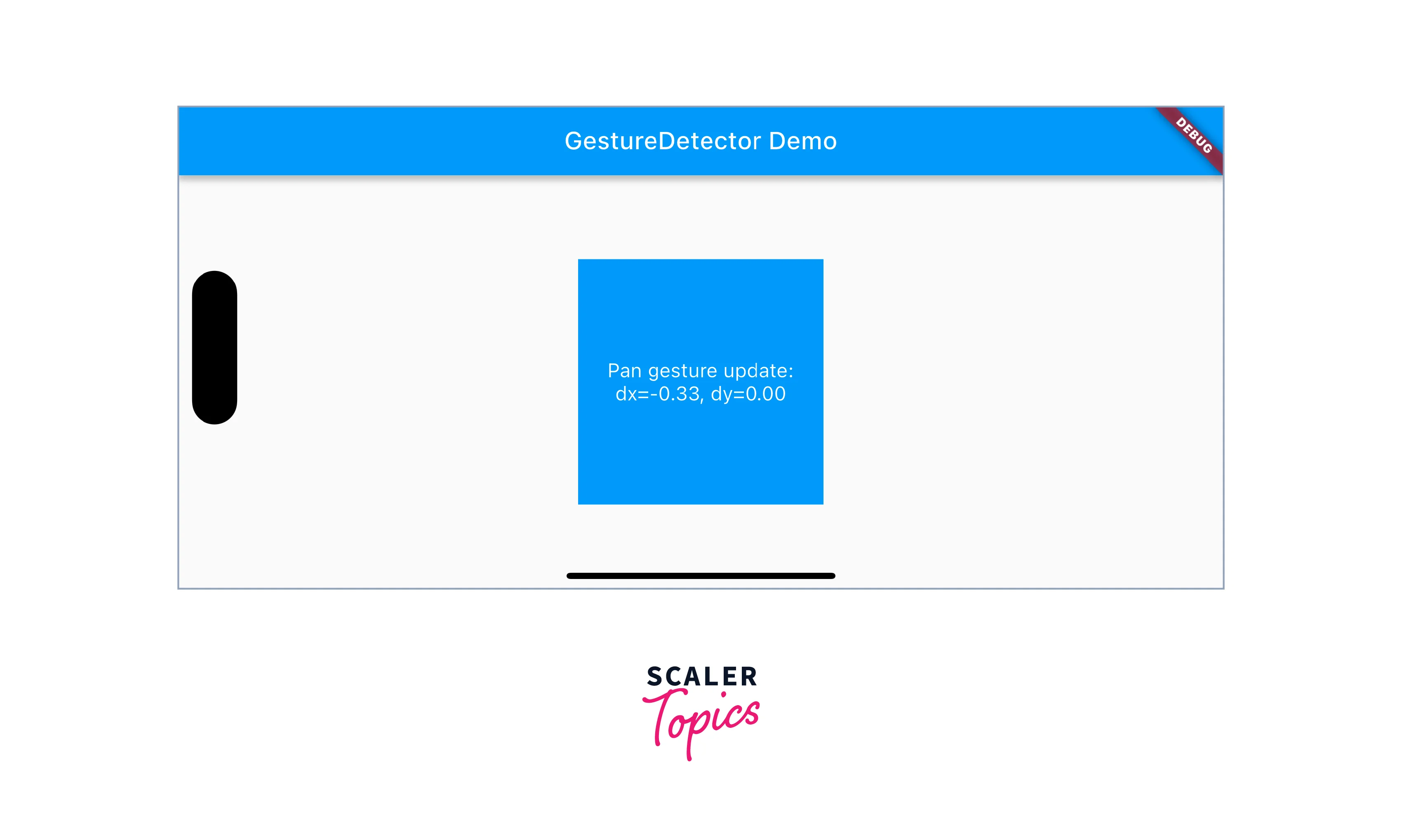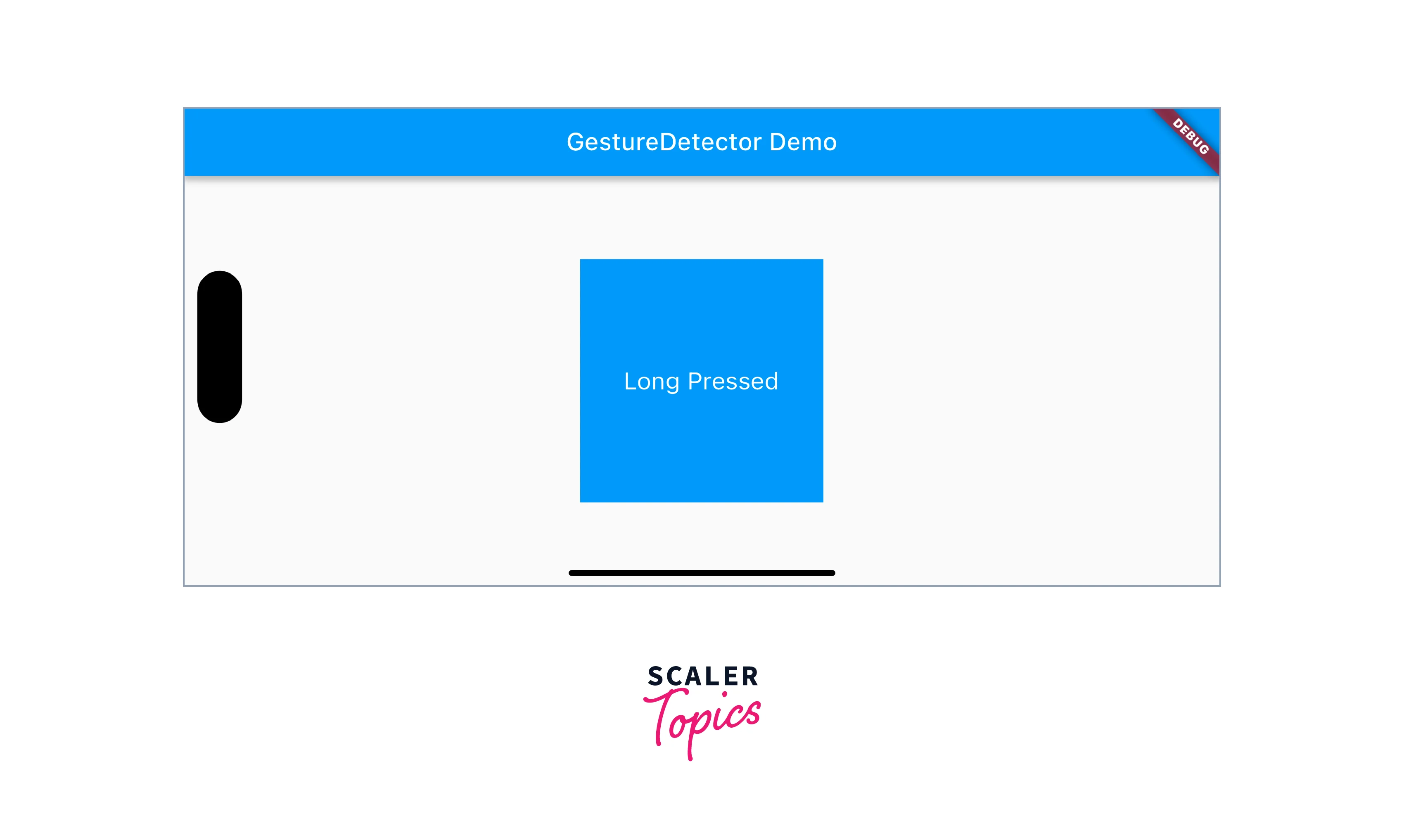GestureDetector in Flutter
Overview
GestureDetector in Flutter is a non-visual widget used to detect and handle user gestures in applications. It supports various gestures like taps, long-presses, double-taps, pans, scales, and drags. By providing callbacks for each gesture, developers can respond to user interactions effectively. GestureDetector flutter offers customization options through properties and advanced techniques like gesture arena management and resampling. It enhances the user experience by enabling interactive and intuitive interactions in Flutter apps.
Role of GestureDetector in Handling User Gestures
GestureDetector flutter acts as a bridge between user input and the application's response. It listens to various gestures performed by the user, such as taps, long-presses, double-taps, pans, scales, vertical and horizontal drags, and many more. Once a gesture is detected, GestureDetector flutter triggers the corresponding callback functions, allowing developers to respond appropriately.
Various gestures supported by GestureDetector
GestureDetector flutter supports a wide range of gestures, enabling developers to cater to different user interactions. Let's explore some of the commonly used gestures and how GestureDetector flutter handles them.
Tap gestures
- Description: Tap gestures occur when the user touches the screen briefly and then lifts their finger.
- Callback: onTap
- Details: The onTap callback is triggered when a tap gesture is detected. It allows developers to implement actions such as navigating to another screen, triggering specific functionalities, or showing feedback to the user.
Long-press gestures:
- Description: Long-press gestures occur when the user presses and holds their finger on the screen for an extended period.
- Callback: onLongPress
- Details: The onLongPress callback is triggered when a long-press gesture is detected. It enables developers to implement functionalities that require a long press, such as showing context menus, initiating drag operations, or activating secondary actions.
Double-tap gestures:
- Description: Double-tap gestures happen when the user quickly taps the screen twice in succession.
- Callback: onDoubleTap
- Details: The onDoubleTap callback is triggered when a double-tap gesture is detected. Developers can utilize this callback to implement features that require double-tapping, such as zooming in on an image, toggling between different views, or performing specific actions.
Pan gestures:
- Description: Pan gestures occur when the user presses their finger on the screen and moves it in any direction.
- Callbacks: onPanStart, onPanUpdate, onPanEnd
- Details: GestureDetector flutter provides multiple callbacks to handle pan gestures. The onPanStart callback is triggered when the pan gesture starts, onPanUpdate is called when the pan gesture is ongoing, and onPanEnd is invoked when the pan gesture ends. These callbacks provide information about the start position, update details, and end position of the pan gesture, enabling developers to implement actions like scrolling, dragging objects, or updating the UI based on the pan gesture.
Scale gestures:
- Description: Scale gestures involve the user's two fingers on the screen, moving closer together or farther apart.
- Callbacks: onScaleStart, onScaleUpdate, onScaleEnd
- Details: GestureDetector flutter provides callbacks to handle scale gestures. The onScaleStart callback is triggered when the scale gesture starts, onScaleUpdate is called during the scale gesture, and onScaleEnd is invoked when the scale gesture ends. These callbacks provide information about the scale factor, focal point, and update details of the scale gesture, allowing developers to implement functionalities like zooming in or out on an image, adjusting the size of UI elements, or applying transformations based on the scale gesture.
Vertical and horizontal drag gestures:
- Description: Vertical and horizontal drag gestures occur when the user drags their finger vertically or horizontally on the screen.
- Callbacks: onVerticalDragStart, onVerticalDragUpdate, onVerticalDragEnd, onHorizontalDragStart, onHorizontalDragUpdate, onHorizontalDragEnd
- Details: GestureDetector flutter provides separate callbacks for vertical and horizontal drag gestures. The onVerticalDragStart, onVerticalDragUpdate, and onVerticalDragEnd callbacks handle vertical drag gestures, while the onHorizontalDragStart, onHorizontalDragUpdate, and onHorizontalDragEnd callbacks handle horizontal drag gestures. These callbacks provide information about the drag's start position, ongoing updates, and end position, enabling developers to respond to vertical or horizontal dragging with functionalities such as scrolling, swiping, or repositioning elements.
Properties
GestureDetector flutter offers various properties that can be used to customize its behavior and enhance gesture recognition. Some of the important properties include:
| Property | Description |
|---|---|
| child | Specifies the child widget that receives gestures. This is the widget that GestureDetector wraps and listens to for user input. |
| behavior | Defines the hit-testing behavior of GestureDetector. It determines how the gesture detector responds when it detects a gesture on the child widget. |
| onTap | Callback triggered when a tap gesture is detected. |
| onLongPress | Callback triggered when a long-press gesture is detected. |
| onDoubleTap | Callback triggered when a double-tap gesture is detected. |
| onPanStart, onPanUpdate, onPanEnd | Callbacks triggered when pan gestures are detected. |
| onScaleStart, onScaleUpdate, onScaleEnd | Callbacks triggered when scale gestures are detected. |
| onVerticalDragStart, onVerticalDragUpdate, onVerticalDragEnd | Callbacks triggered when vertical drag gestures are detected. |
| onHorizontalDragStart, onHorizontalDragUpdate, onHorizontalDragEnd | Callbacks triggered when horizontal drag gestures are detected. |
Gesture Recognition and Handling
Gesture Recognition:
- GestureDetector flutter utilizes a combination of touch event processing and gesture recognition algorithms to identify different types of user gestures. It tracks the sequence and movement of touch events to determine if they correspond to specific gestures.
- Gesture recognition includes the identification of tap gestures, long-press gestures, double-tap gestures, pan gestures, scale gestures, and more. The GestureDetector flutter widget analyzes the touch events and compares them against predefined gesture patterns to determine which gesture is being performed.
Gesture Callbacks:
- Once a gesture is recognized, GestureDetector flutter triggers the corresponding callback function associated with that specific gesture. These callbacks allow developers to define custom behaviors or actions in response to user interactions.
- For example, the onTap callback is triggered when a tap gesture is detected, onLongPress is invoked for a long-press gesture, onDoubleTap is called for a double-tap gesture, and so on. Developers can implement their desired functionality within these callback functions.
Gesture Arena:
- GestureDetector flutter operates within a gesture arena, which manages the priority and conflicts between different gestures. The gesture arena ensures that gestures are recognized and handled in the correct order and that conflicts between gestures are resolved appropriately.
- This means that if multiple gestures are recognized simultaneously, the gesture arena determines which gesture takes precedence based on predefined rules or priorities.
Gesture Resampling:
- GestureDetector flutter incorporates gesture resampling techniques to improve the accuracy and responsiveness of gesture recognition. Gesture resampling involves analyzing touch event data at higher resolutions and sampling rates to reduce errors and provide more precise gesture detection.
- By resampling touch events, GestureDetector can better recognize and interpret subtle or complex gestures, resulting in a smoother and more reliable user experience.
Custom Gesture Recognizers:
- While GestureDetector flutter provides built-in support for common gestures, developers can also create custom gesture recognizers for more specialized or unique gestures. Custom gesture recognizers allow developers to define their own gesture detection logic based on specific requirements.
- With custom gesture recognizers, developers have full control over the recognition and handling of gestures, enabling them to create tailored interactions and behaviors within their Flutter applications.
Advanced Gesture Handling Techniques
In addition to the built-in gesture recognition and handling capabilities, GestureDetector in Flutter offers advanced techniques for more nuanced and complex gesture interactions. These techniques provide developers with greater control and flexibility in managing gestures within their applications.
Gesture Displacement:
- Gesture displacement refers to the ability to track and calculate the distance and direction of a gesture's movement. GestureDetector enables developers to measure and utilize the displacement of gestures for implementing specific behaviors. Developers can create features such as swipe gestures.
Gesture Velocity:
- GestureDetector allows developers to access the velocity information of a gesture, which represents the speed at which the gesture is performed. Velocity can be a crucial factor in determining the intensity or magnitude of an action triggered by a gesture.
Gesture Constraints:
- GestureDetector flutter supports the application of constraints to gestures, allowing developers to define specific conditions that must be met for a gesture to be recognized. These constraints help ensure that gestures are only recognized and handled when specific criteria are fulfilled.
Gesture Exclusion Zones:
- Gesture exclusion zones allow developers to define areas or regions where certain gestures should not be recognized or handled. This technique is useful when developers want to reserve specific portions of the screen for different interactions or prevent accidental recognition of gestures in certain areas.
Gesture Composition:
- GestureDetector flutter supports gesture composition, which involves combining multiple gestures or recognizing complex gesture patterns. This technique allows developers to define intricate interactions by combining simple gestures or detecting specific sequences of gestures.
ExampleApp
We are gonna build a basic app to demonstrate gesture detector in Flutter and how it detects gestures.
We have a box in the center of the app which displays the gesture detected.
Source code of the app looks like this:
main.dart file:
The output of the app will look something like this:



Conclusion
- GestureDetector is a powerful widget in Flutter that enables developers to detect and handle user gestures in their applications.
- It provides built-in support for various gestures such as taps, long-presses, double-taps, pans, scales, and more.
- The properties of GestureDetector allow customization of gesture behavior, including hit-testing behavior, callbacks for specific gestures, and advanced gesture handling techniques.
- Gesture recognition and handling in GestureDetector are based on touch event processing and gesture recognition algorithms.
- Gesture detection and handling can be combined with other Flutter widgets and animations to create engaging user experiences.
- Advanced gesture handling techniques such as gesture displacement, velocity, constraints, exclusion zones, composition, and customization offer greater control and flexibility in managing gestures.
